And a Rough-legged Hawk thrown in for good measure.
It was mostly a very slow morning for birds two days ago during a trip to Bear River MBR and vicinity. But at one point I had to make a choice between three different potential raptor subejcts – a Rough-legged Hawk I saw dive on prey next to the road in front of me, a second roughie that soon after was perched on a fence post across the river and a male American Kestrel perched in a tree on my side of the river.
For a variety of reasons the kestrel seemed the best choice so I approached him as close as was practical and hoped he wouldn’t spook.
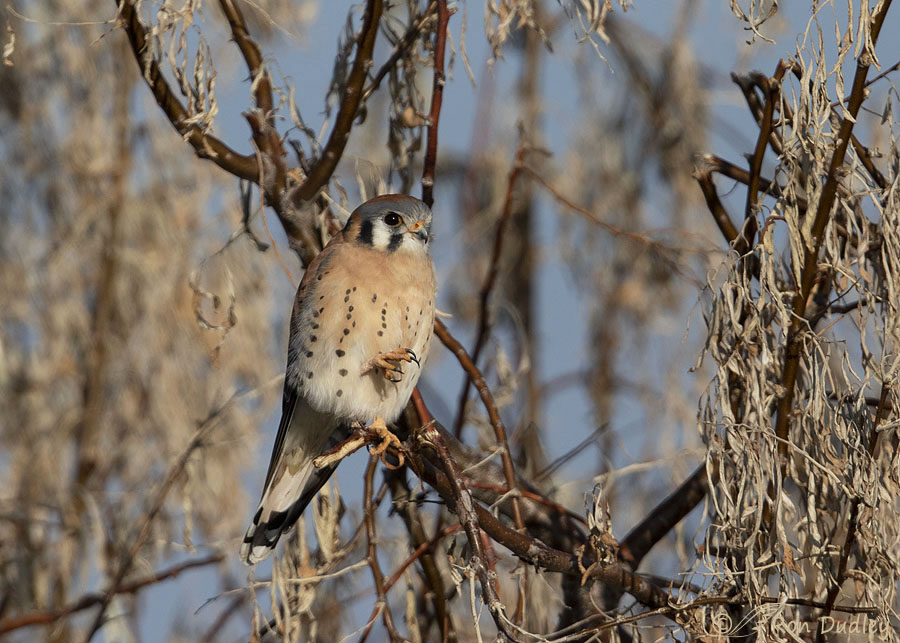
1/5000, f/6.3, ISO 320, Canon 7D Mark II, Canon EF 500mm f/4L IS II USM + EF 1.4 III Extender, not baited, set up or called in
He didn’t but he still wasn’t very close so these photos of him have been cropped significantly and don’t have great detail..
For a while he kept a close eye on my pickup but he soon relaxed and pulled his right foot up into his belly feathers in typical kestrel fashion. This shot caught him just before his foot disappeared into his plumage.
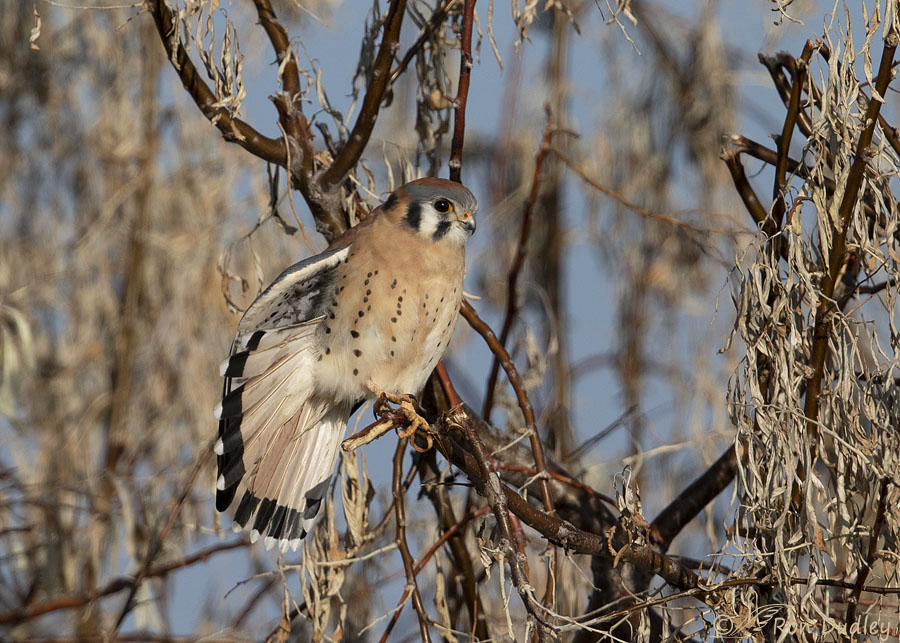
1/5000, f/6.3, ISO 320, Canon 7D Mark II, Canon EF 500mm f/4L IS II USM + EF 1.4 III Extender, not baited, set up or called in
Some time after that he begain an extensive stretching routine. First he stretched his tail, right wing and right leg and then he…
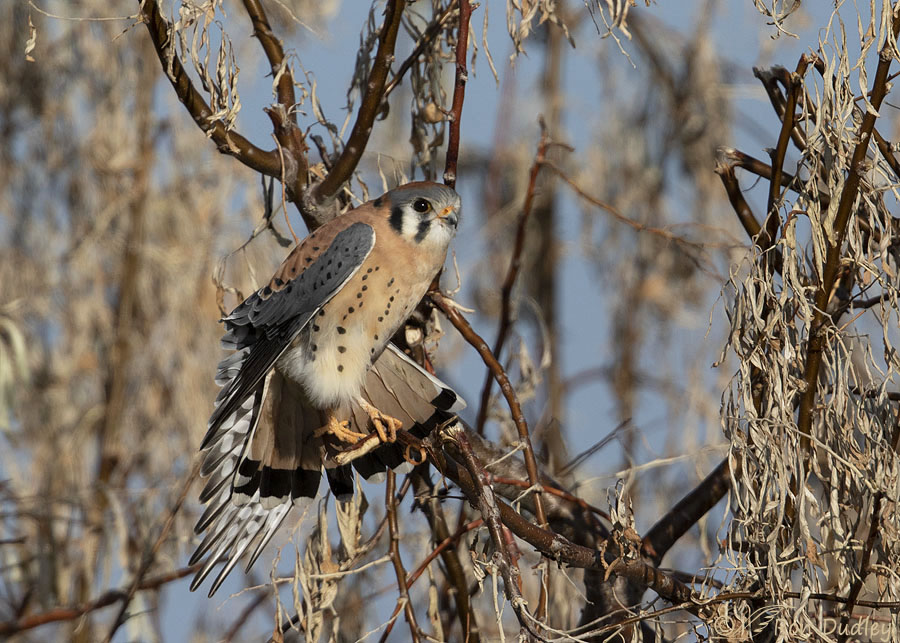
1/4000, f/6.3, ISO 320, Canon 7D Mark II, Canon EF 500mm f/4L IS II USM + EF 1.4 III Extender, not baited, set up or called in
switched sides with his tail twisted to his left side.
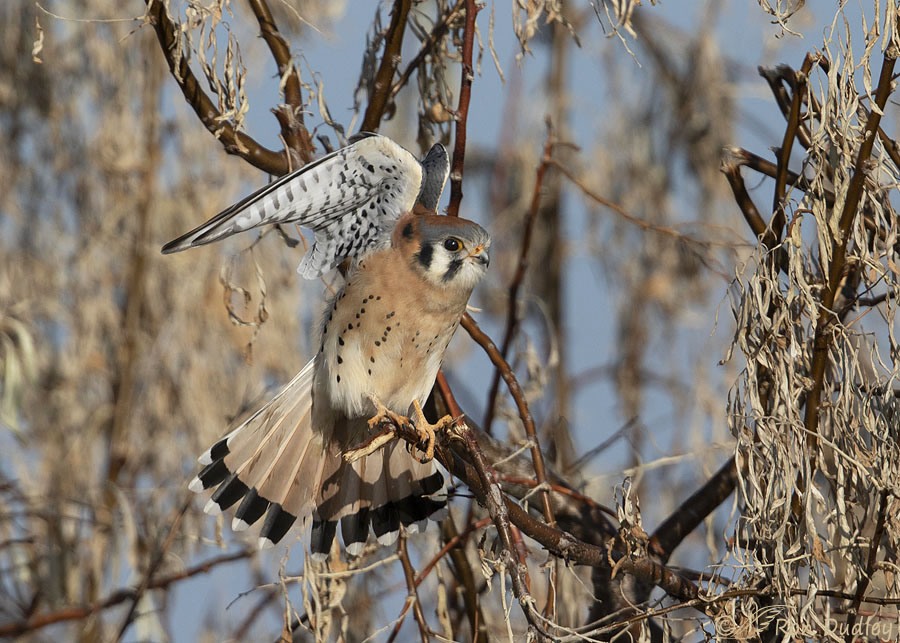
1/4000, f/6.3, ISO 320, Canon 7D Mark II, Canon EF 500mm f/4L IS II USM + EF 1.4 III Extender, not baited, set up or called in
Next came a vertical wing lift to stretch his shoulder muscles.Since stretching is often an indicator of imminent takeoff I hoped for a chance at takeoff and flight shots but that didn’t happen. He just settled in on his perch again.
But eventually he took exception to the presence of the Rough-legged Hawk on the other side of the river and…
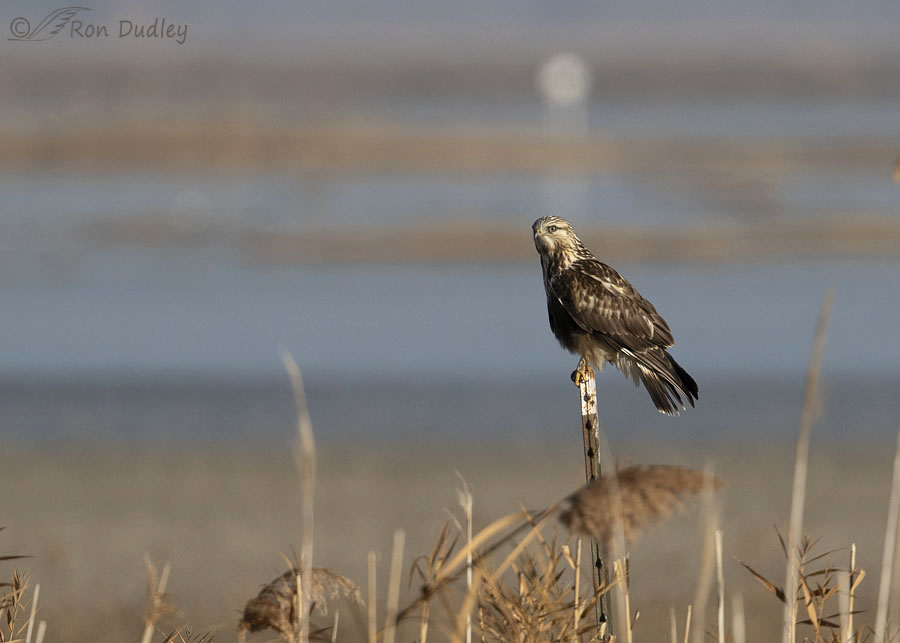
1/4000, f/6.3, ISO 320, Canon 7D Mark II, Canon EF 500mm f/4L IS II USM + EF 1.4 III Extender, not baited, set up or called in
dived on it a time or two in an attempt to drive it off. Sadly I didn’t get any photos with both birds in the frame but here the hawk is still in an alert pose after being attacked. The roughie held its ground and didn’t fly off.
And no, I don’t know what the bright glob is above the hawk’s head.
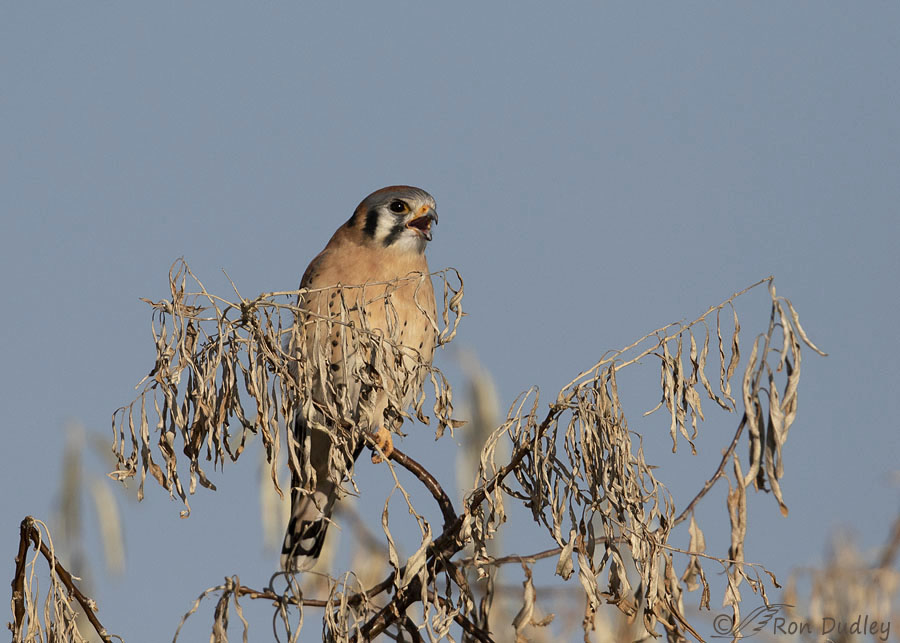
1/5000, f/6.3, ISO 320, Canon 7D Mark II, Canon EF 500mm f/4L IS II USM + EF 1.4 III Extender, not baited, set up or called in
Then the kestrel returned to a different branch in the same tree and repeatedly tried to hack up a pellet. During the process I fired off several bursts but if he was successful I missed capturing the pellet falling to the ground.
Kestrels have been pretty scarce all summer but in the areas I haunt I’m finally beginning to see more of them. Hopefully I’ll be able to get a little closer to the next one I photograph.
Ron


A late comment as It was a busy day doing a bird survey among other things, but just wanted to chime in on the beautiful raptor photos. The Kestrel is definitely giving you the stink eye along with some nice poses.
What a fun series! (Poor Roughie, just sitting there minding his own business.)
The Kestrel looks like he’s waving at you to join him in doing the Hokey Pokey, with all those wings “in” and “out.”
Marty, this morning, two days later, I found that same kestrel on the same perch. No roughie in the area though.
Sensational series Ron! Thanks for sharing!
Charlotte Norton
Thanks, Charlotte.
Love those little kestrels. The Napoleons of raptors.
I’ve never heard it put that way but you’re absolutely right!
So nice to see you getting some more birdie action again, however long it lasts. Love raptors and esp that last kestrel shot with such great light and background
Thank you, Granny Pat.
I looked at and loved the Kestrel photos early this morning and came back this afternoon to read comments and thought I’d comment about the one-foot stance. Standing on one foot is commonly seen being done by raptors, shorebirds, ducks, herons and many other birds. At the same time, while resting, the head is often turned to tuck the beak within the feathers of the back. If you are a bird, feathers provide great insulation so it is the bare spots where heat can be lost. So birds put those bare areas into the plumage as much as possible to minimize any heat loss.
Thanks very much for the interesting info, Dan.
Such pretty photos of the kestrel, Ron. I was mildly surprised to read that the kestrel was attempting to make the hawk leave the area… I had assumed the larger bird would have the advantage, so to speak. Will it always be the smaller bird, or does it depend on many factors?
Nina, if they actually get into a physical flght the larger bird would have the advantage, a huge one. But smaller birds know they’re faster and more agile so they often harrass larger birds, raptors especially. It’s called mobbing.
I rarely see a large bird mobbing one that’s a lot smaller.
What a glorious morning! Thanks for sharing the experience in a story! Wonderful experience for the ‘Ron Bird Blog Posse’ – felt like I was in your truck with you as the morning unfolded. The Kestral was an excellent choice!
Kathleen, I appreciate what you said about feeling like you were actually there. When I tell the story of my experience with a bird, in some detail like this, I always wonder if my readers think I blabber on too much. But I know my readers love birds like I do so I often take a chance and go into a fair amount of detail.
Blab away! I chose to subscribe to you because of your story-telling.
Couldn’t agree more. Your blog is so much more than just a pretty pic, Ron.
Simply love the look on Mr Kestrel’s face, and I’d swear he’s got his eye on you specifically (not your truck) with those sidelong glances in the 2nd, 3rd & 4th images, as in “I’ll show you some stretches, Mr Dudley” ….
It’s so very nice that you had a selection of raptors to choose from, hope you (and we) are treated to more in the coming weeks!
You may be right, Chris. I always wonder if they’re looking at me (or my lens) instead of my pickup. It probably varies.
I did enjoy those stretches – and admire the flexibility.
I am thrilled that this beauty allowed the papparazzi close (even if not close enough for you).
Thank you. So much.
Nope, not close enough for me , EC. But I’ll take it, especially from a kestrel.
Nice series.
Thanks, April.
Nice! Kestrels are ALWAYS good. He did provide a few interesting poses. Roughie on the post is a good shot and indicates the actual size of the bird. Looks like the “blob” was in motion at some point with a trail down to the Roughie’s head whatever it is….
He did provide a few interesting poses. Roughie on the post is a good shot and indicates the actual size of the bird. Looks like the “blob” was in motion at some point with a trail down to the Roughie’s head whatever it is…. 
We actually got about 4″ of snow with some moisture in it – we’ll take it….. For once the predicted wind didn’t materialize…
For once the predicted wind didn’t materialize…
Congrats on the snow, Judy. I hope that means you’ll be able to stop hauling water!
Been on the well for a couple of weeks now – glad the creek came back before the ground froze and don’t have to deal with the water tank freezing! Should hold now……..
Great shots! I particularly like the Kestrel stretching. Haven’t seen a Kestrel here for more than three years.
When I see a Roughie near us I feel very lucky. Usually the only time I see them is during migration either Spring or Fall, but too far away to be in a picture.
Dick, then I suspect you’ll be jealous when I tell you that this morning I was within 15′ of a roughie and it didn’t fly off. The bird was perched on a sign and I had to get that close to get by it on the road. It almost spooked but it didn’t. .
These photos are amazing and just bring pure delight to my world.
Please take care,
Kaye
Park City, UT
Thank you, Kaye.
The kestrel shots are exquisite and they feel very intimate. The bird gives the impression of looking directly at you and still continuing with his morning ritual, not disturbed by your presence.
Thank you.
He was very calm in my presence, Deanna – especially for a kestrel. But then I wasn’t all that close to him either.
LOVED LOVED LOVED seeing so many good shots of the Kestrel– the most
beautifully-marked of all birds, to my taste, anyway. And when you described it
as standing on one leg with the other foot drawn into its breast feathers “in
typical Kestrel fashion” I wondered what purpose such an unusual behavior could serve ?
At the beach, I saw birds with one foot up, persistently, even when they wanted to get away from us as we walked. I wondered this as well.
So glad to see Feathered Photography this morning! I was thinking about asking Mr. Dudley to move to Florida, where we are fortunate to have birds, at least for now.
Don’t think I could handle Florida, Mary. Too hot and humid in the summer and too many snowbirds on the roads in the winter.
I’m guessing it provides rest for the other leg and foot, Kris. And maybe it even helps to prevent bumblefoot – a common problem with birds that have lost one leg/foot because they have to spend so much time on the one they have left.
Things are picking up for our Feathered Photographer. I think that whole stretching routine for the Kestrel is equal to us having our first cup of coffee which is what I am doing right now. Nice shots of the tail feathers etc. I rarely saw Kestrels this summer, but just now starting to see them again.
I like your coffee analogy, Everett. I can’t imagine going without a gallon or two of coffee in the AM.